

An alternative framework: The Five Stage Model of Online Teaching and Learning. The CoI framework has been highly influential in guiding online teaching practices.

As noted, the CoI theoretical framework suggests that online learning results from the interaction between the three elements of the framework: social presence, cognitive presence and teaching presence. Think UDL. Community of Inquiry: An Online Teaching Framework - Educational Technology @ HCT. DGGS CPD. University College London – Birkbeck University of London – UCL Institute of Education. UDL: The UDL Guidelines. Robert Gagne Events of Instruction and ASSURE -Instructional Design Models, Theories & Methodology. Robert Gagne Events of Instruction Robert M.
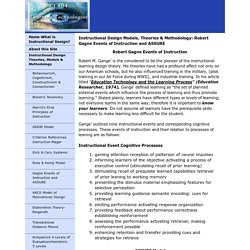
Gange' is the considered to be the pioneer of the instructional learning design theory. His theories have had a profound affect not only on our American schools, but he also influenced training in the military, (pilot training in our Air Force during WWII), and industrial training. Toohey’s learning-process-model-hughes – universityteachingandlearning. Understanding Learning Processes. Remember, what your student does is actually more important to their learning than what you, as the teacher, do.
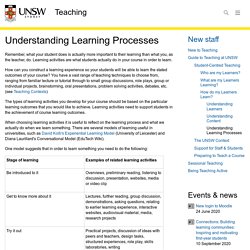
Learning activities are what students actually do in your course in order to learn. How can you construct a learning experience so your students will be able to learn the stated outcomes of your course? You have a vast range of teaching techniques to choose from, ranging from familiar lecture or tutorial through to small group discussions, role plays, group or individual projects, brainstorming, oral presentations, problem solving activities, debates, etc. (see Teaching Contexts) Building capability in a time of crisis – The Edvisor. Educators today sit on the cusp of the known unknown.
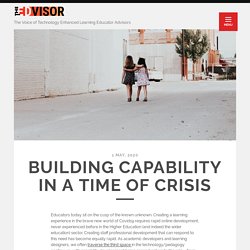
Creating a learning experience in the brave new world of Covid19 requires rapid online development, never experienced before in the Higher Education (and indeed the wider education) sector. Creating staff professional development that can respond to this need has become equally rapid. As academic developers and learning designers, we often traverse the third space in the technology/pedagogy continuum, with capability development being second nature to the role – from ad hoc and at elbow to more formal professional development and training. This professional development, with the consequences of Covid19 looming large, has now become central to institutional responses to the crisis, with our roles enabling institutions to achieve this at pace and scale.
Having recently led a whole of institution approach to professional development for online learning, I have reflected on lessons learnt so far. ResearchED. EJ1122050. “Trong cái rủi có cái may” – seeing the silver lining of Emergency Remote Teaching through an asset-based lens – EdTechSIG. By Karen Benson This is the first of two posts on the unexpected benefits that emergency remote teaching can bring.
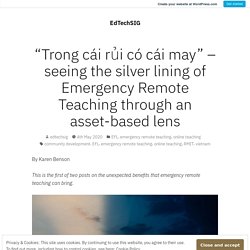
As COVID-19 catapulted English language teaching into the virtual realm, whole populations of teachers and learners have ventured together into the unknown. Neither teachers nor students nor curriculum writers nor ed-tech departments were prepared as we scrambled to go online and deliver a good experience for our learners in what we now refer to as “emergency remote teaching” (ERT). And, I am sure we are all still continuously reviewing and fine tuning our ERT. But as teachers, institutions, indeed as an industry, this is also an opportunity to capture, build on, and promote new ways of learning and new capabilities that this crisis is affording our learners.
Emergency remote teaching (ERT) is a temporary shift of instructional delivery to an alternate delivery mode due to crisis circumstances. From the outset, we needed to address concerns from parents. About the Author. What is Appreciative Inquiry? A Brief History & Real Life Examples. In an unpredictable global business environment, it’s tempting to approach strategy with specific goals already in mind.

More often than not, these are problem-focused and aimed at mitigating threats. Businesses commonly focus on what’s not working and adopt ‘root cause’ mindsets, only to find themselves facing a set of different, but related questions down the line. Kirschnered. In the final chapter of our book How Learning Happens: Seminal Works in Educational Psychology and What They Mean in Practice, Carl Hendrick and I briefly describe ten deadly sins of education.
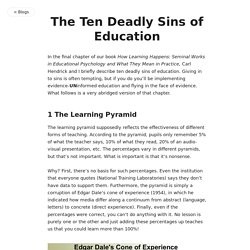
Giving in to sins is often tempting, but if you do you’ll be implementing evidence-UNinformed education and flying in the face of evidence. What follows is a very abridged version of that chapter. 1 The Learning Pyramid. Filling the pail – "Education is not the filling of a pail, but the lighting of a fire." – As W. B. Yeats never said. 12 building blocks to use learning technologies effectively – Building Block 1: Activating relevant prior knowledge. Mirjam Neelen & Paul A. Kirschner The world is in the grip of the corona virus. Schools are closing (Mirjam’s children have been home since Friday and will stay home for at least 2 weeks) and people are urged to work from home if possible.
Education institutions and organisations alike are trying to figure out how to help their students or workers learn while at home. Tips for effective teaching if you have to teach at a distance – Paul's Random Thoughts / Gedachten. This blog is based on the book ‘Lessons for Learning’, a translation of a recent Dutch language book, which should be coming out before the summer.

The book is a collaboration between Tim Surma, Kristel Vanhoyweghen, Dominique Sluijsmans, Gino Camp, Daniel Muijs, and myself. Because of the Corona pandemic, we’re all going through a period that none of us have ever experienced. With respect to teaching and learning, kids can’t attend school and we must help them learn at home. And this might last weeks or months. Fortunately, online education offers a solution, but the instructional techniques involved are not (completely) the same as what we do in the classroom during face-to-face education. David Didau – Brain food for the thinking teacher. Zest for Learning… into the rainforest of teaching and school leadership. Engaging Students Online – ANU Online Coffee Courses. More and more material is being put online for students to use, but are they engaging with it?
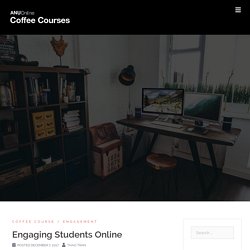
It’s a common scenario for discussion forums to remain empty, and for teachers to be unsure if students are using the material they are putting online. How can you foster student activity, conversation, and engagement in your online courses? This coffee course will discuss strategies for encouraging and facilitating student engagement in your course sites. Home - Learning and Teaching at Navitas. Search results - Evidence 4 Impact. Moore's Theory of Transactional Distance-Instructional Design Models, Theories & Methodology. By Daniel Bornt (completed Aug. 22, 2011) Moore’s Theory of Transactional Distance has a direct bearing on e-learning.

It explains and quantifies the learning relationship between instructor and student in the e-learning situation, where there is a substantial physical or temporal distance between the two. Five thoughts on harnessing educational research – Institute for Effective Education.